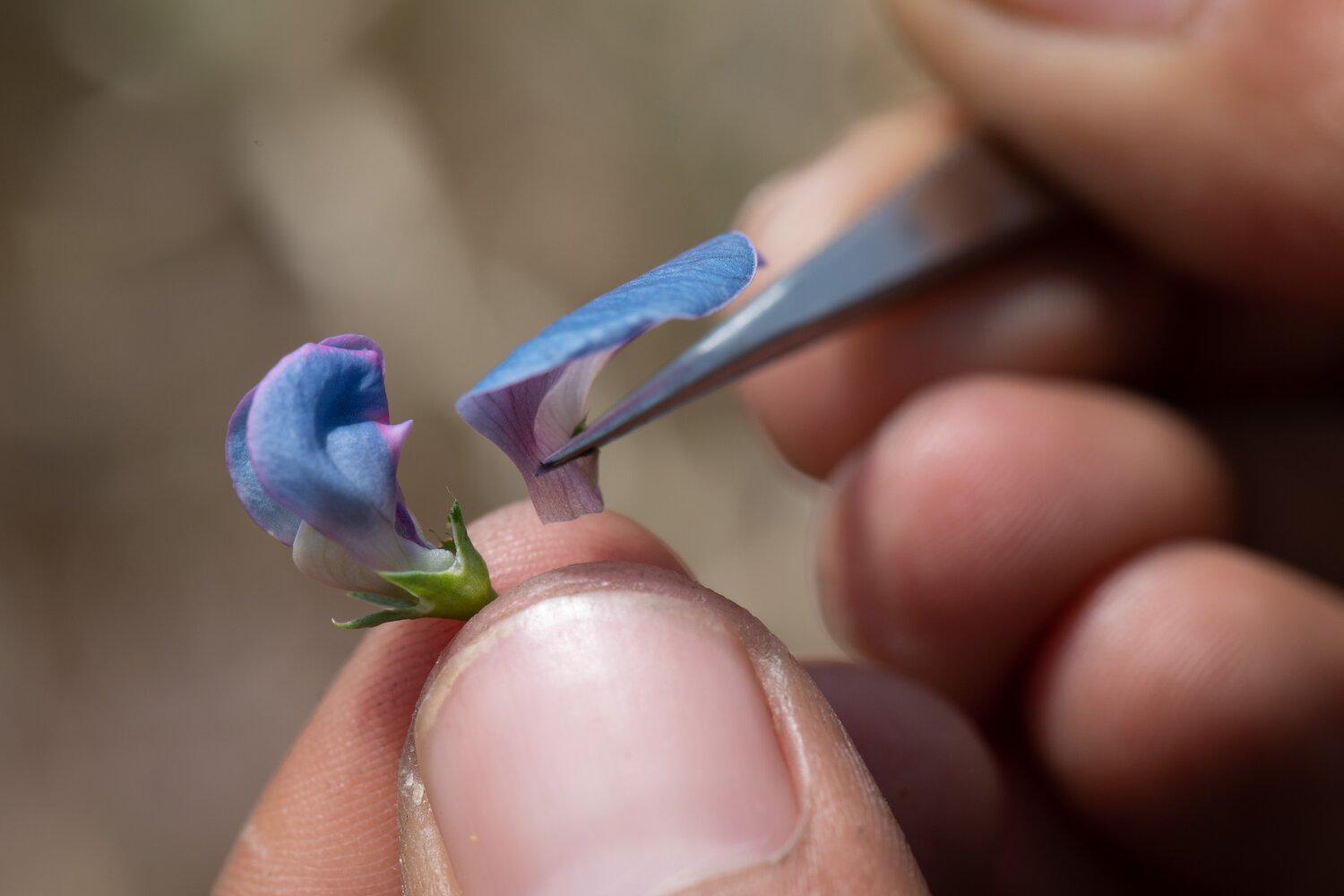Grasspea
Why grasspea?
Grasspea (Lathyrus sativus L.) is a hardy crop, able to withstand extreme environmental conditions such as drought, floods and poor soils. For this reason, it is sometimes considered a famine food, eaten when other crops have failed, and a climate-change-resilient crop. It is grown in pockets in South Asia, southern Europe and the Horn of Africa.
A major problem with grasspea is that its seeds contain a neurotoxin, β-N-oxalyl-L-α,β-diaminopropionic acid (β-ODAP), that can lead to paralysis in adults when consumed as a major part of an unbalanced diets over long periods. Low-neurotoxin varieties developed by exploiting the genetic diversity of the crop offer the scope to make grasspea a safe food constituent. Its productivity can be seriously affected by the noxious weed broomrape (Orobanche sp.) and by aphids.
What we achieved
Collecting
- 306 seed samples of 28 species of grasspea wild relatives were collected from nine countries: Armenia, Azerbaijan, Cyprus, Georgia, Italy, Lebanon, Nepal, Portugal and Spain.
Pre-breeding and evaluation
- Four wild relatives of grasspea—Lathyrus cicera, L. heirosolymitanus, L. marmoratus and L. inconspicuous—were crossed with cultivated lines of grasspea in pre-breeding efforts.
- 420 accessions belonging to 12 Lathyrus species were evaluated for β-ODAP content and for resistance to broomrape. This identified grasspea wild relatives that had low levels of β-ODAP and wild relatives with resistance to two forms of broomrape—a major constraint to cultivation of grasspea in the Mediterranean region. These were subsequently crossed with cultivated lines in pre-breeding projects.
- Speed breeding, a technique developed by NASA, was used to accelerate development of new grasspea varieties.
- All seed samples of grasspea wild relatives and materials generated by the pre-breeding program are available from the International Center for Agricultural Research in the Dry Areas (ICARDA) through SMTA.
- 251 pre-breeding lines advanced through speed breeding and multiplied for on-farm testing.

Project partners
Collecting
- Armenian Botanical Society, Yerevan, Armenia
- Genetic Resources Institute, Azerbaijan National Academy of Sciences, Baku, Azerbaijan
- Agricultural Research Institute, Ministry of Agriculture, Natural Resources and Environment, Nicosia, Cyprus
- Ethiopian Institute of Agricultural Research, Debre Zeit, Ethiopia
- Institute of Botany, Ilia State University, Tbilisi, Georgia
- National Botanical Garden of Georgia, Tbilisi, Georgia
- University of Pavia, Italy
- Lebanon Agricultural Research Institute, Rayak, Lebanon
- National Agriculture Genetic Resources Center, Kathmandu, Nepal
- Museu Nacional de História Natural e da Ciéncia, Lisbon, Portugal
- National Institute for Agricultural and Food Research and Technology, Madrid, Spain
Pre-breeding and evaluation
Lead Institute: ICARDA, Rabat, Morocco
Partners:
- Institute National de la Recherche Agronomique, Rabat, Morocco
- John Innes Center, Norwich, UK
Grasspea key collections, materials and data
Grasspea collections
- The largest grasspea collection is conserved at the ICARDA genebank.
- Of the 306 samples collected, 261 samples of 26 wild Lathyrus species from eight countries are conserved in the Millennium Seed Bank.
- The Genesys PGR database also includes information about grasspea accessions in genebanks worldwide.
Pre-breeding materials
- All pre-breeding materials and promising introgressed lines are being advanced at ICARDA and are available for sharing through SMTA.
Data
- All data from the crop wild relatives (CWR) grasspea pre-breeding and evaluation projects are available in the Germinate grasspea database.
Grasspea stories
Crop Trust stories
-
Accessible Software for Accessible Seeds. https://www.croptrust.org/news-events/news/accessible-software-for-accessible-seeds/. 25 May 2022.
-
Fast-Tracking Food Security Using Space Science. https://www.croptrust.org/news-events/news/fast-tracking-food-security-using-space-science/. 7 April 2021.
-
Pre-breeding work with grasspea and finger millet gets a boost. https://www.croptrust.org/blog/pre-breeding-gets-a-boost/. 2 October 2019.
-
How Does a Toxic Grasspea Save Lives? https://www.croptrust.org/news-events/news/how-does-a-toxic-grasspea-save-lives/. 2 December 2014.
Partner stories
- Using wild relatives to toughen up staple crops. https://www.icarda.org/media/blog/using-wild-relatives-toughen-staple-crops. 18 April 2021.
Relevant publications
- Abdallah, F., Kumar, S., Amri, A., Mentag, R., Kehel, Z., Mejri, R.K., El Abidine Triqui, Z., Hejjaoui, K., Baum, M., Amri, M. 2021. Wild Lathyrus species as a great source of resistance for introgression into cultivated grass pea (Lathyrus sativus L.) against broomrape weeds (Orobanche crenata Forsk. and Orobanche foetida Poir.). Crop Science 61(1): 263–276.
- Das, A., Parihar, A.K., Barpete, S., Kumar, S., Gupta, S. 2021. Current perspectives in reducing β-ODAP and improvement of potential agronomic traits in grass pea (Lathyrus sativus L.). Frontiers in Plant Sciences 12:703275. https://doi.org/10.3389/fpls.2021.703275.

